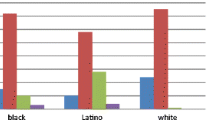Abstract
This article investigates the existence and sources of earnings differentials between black Americans and black immigrants, and between black and nonblack immigrants. Employing the Public Use Sample of the 1980 census, the gross earnings differentials between black immigrants and black Americans are estimated to be 8.7 percent in favor of Americans (i.e., Americans earn 8.7 percent more than immigrants). About 2 percentage points and 6.7 percentage points of the gross differential are, respectively, due to differences in average characteristics and in returns to the characteristics. The gross differential between black and nonblack immigrants is 22.1 percent in favor of nonblack, of which 13.8 percentage points are due to differences in average characteristics and 8.3 are due to differences in returns to characteristics.
Similar content being viewed by others
Notes
For examples of this literature see G.J.Borjas,International Differences in the Labor Market Performance of Immigrants (Michigan: W.E. Upjohn Institute for Employment Research, 1988); B.R. Chiswick, “The Effect of Americanization of the Earnings of Foreign-born Men,”Journal of Political Economy, 86 (October 1978), 897-921; C. Reimers, “Labor Market Discrimination Against Hispanic and Black Men,”Review of Economics and Statistics, 65 (November 1983), 570-579; J.B. Stewart and T. Hyclak, “An Analysis of the Earning Profiles of Immigrants,”The Review of Economics and Statistics, 66 (May 1984), 292-296. Also, an excellent survey of this literature is provided by M.J. Greenwood and J.M. McDowell, “The Factor Market Consequences of U.S. Immigration,”Journal of Economic Literature, 24 (December 1986), 1738-1772.
For examples of this literature see M.Corcoran and G.J.Duncan, “Work History, Labor Force Attachment and Earnings Differences Between the Races and Sexes,”Journal of Human Resources, 14 (Winter 1979), 3–20; R. Price and E. Mills, “Race and Residence in Earnings Determination,”Journal of Urban Economics (January 1986), 1-18; S.A. Low and D.S. Villegas, “The Analysis of Wage Differentials,”Southern Economic Journal, 54 (October 1987), 449-462; H.J. Aaron, “Symposium on the Economic Status of African-Americans,”Economic Perspective, 4 (Fall 1990), 3-8; G.D. Jaynes, “The Labor Market Status of Black Americans: 1939–1985, ”Economic Perspective, 4 (Fall 1990), 9-24; J. O’Neill, “The Role of Human Capital in Earnings Differences Between Black and White Men,”Economic Perspective, 4 (Fall 1990), 25-46.
The 1980 census reports a stock of 815,720 foreign-born blacks. This accounts for 5.8 percent of all foreign-born individuals in the United States. In addition, the corresponding figures for the 1950, 1960, and 1970 census were 1.1 percent, 1.3 percent, and 2.6 percent, respectively. Thus, the share of immigrants who are black has grown by about 100 percent each decade over the 1960–1980 period.
See Stewart and Hyclak, “An Analysis of the Earning.” Also see Reimers, “Labor Market Discrimination.”
K.M.Murphy and F.Welch, “Empirical Age-Earnings Profiles,”Journal of Labor Economics, 8 (1990), 202–229.
See Chiswick, “The Effect of Americanization,” 904.
E.Fujii and J.Mak, “On the Specification of the Income Equation for Immigrants,”Southern Economic Journal, 49 (April 1983), 1145.
See Stewart and Hyclak, “An Analysis of the Earning,” and P.E. Gabriel and S. Schmitz, “The Relative Earnings of Native and Immigrant Males in the United States,”Quarterly Review of Economics and Business, 27 (Autumn 1987), 91–101.
See R.Price and E.Mills, “Race and Residence in Earnings Determination,”Journal of Urban Economics, 17(1985), 1–18.
Since more than 98 and 95 percent of black and nonblack immigrants, respectively, in our samples (described later) live in a SMSA, the analysis is confined to individuals residing in SMSAs.
Discrimination is traditionally measured by the residual difference, which is the sum of differences in estimated coefficients, including the intercept, between the two groups weighted by the mean of the characteristics of the minority group. For a detailed explanation of the traditional decomposition methodology, see A.S.Blinder, “Wage Discrimination: Reduced Form and Structural Estimates,”Journal of Human Resources, 8 (Fall 1973), 436–455. Also see R. Oaxaca, “Male-Female Wage Differentials in Urban Labor Markets,”International Economic Review, 14 (October 1973), 693-709.
J.D.Jackson and J.T.Lindley, “Measuring the Extent of Wage Discrimination: A Statistical Test and a Caveat,”Applied Economics, 21 (October 1989), 515–540.
G.J.Borjas and S.G.Bronars, “Immigration and the Family,”Journal of Labor Economics, 9 (April 1991), 123–149.
Stewart and Hyclak utilized 1970 census data and estimated one equation for all immigrants. The effect of race is accounted for by including a dummy variable and its interaction with years since migration. Such a model implicitly assumes that all workers regardless of race face the same wage structure in the labor market.
The authors wish to thank an anonymous referee of this journal for suggesting caution in interpreting the residual difference as a measure of discrimination. The residual difference can arise from either discrimination and/or from unobserved productivity differences due to such factors as, for example, differential schooling quality. For a discussion of this subject see S.W. Polachek, “Potential Biases in Measuring Male-Female Discrimination,”Journal of Human Resources (Fall 1975), 205-229.
About this article
Cite this article
Daneshvary, N., Schwer, R.K. Black immigrants in the U.S. labor market: An earnings analysis. The Review of Black Political Economy 22, 77–98 (1994). https://doi.org/10.1007/BF02689974
Issue Date:
DOI: https://doi.org/10.1007/BF02689974




